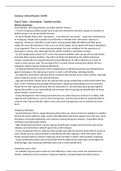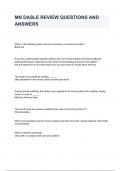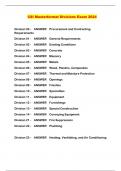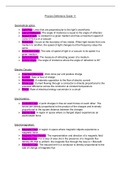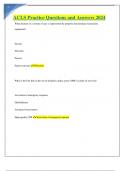Fiekl & Taycor – Stlrlotyping – Cogniton and Biae
Blatant Stereotypes
Social Identtyy Self-Categorizatony and Other Identty heories
- To have intergroup confictt people have to perceive themselves and other people as members of
distinct groups Four group identity theoriest
- (1) Social identity theory (SIT)t interactions even between two people range from interpersonal
to intergroup People seek a positive social identity to maintain their self-esteem Ingroup vs
outgroup Temporary reductions in self-esteem among people highly identiied with their group
might well cause discrimination in the service of social changet but the global self-esteem hypothesis
is not supported There is a minimal group paradigmt the base conditions for the experience of
belonging in a groupt then add progressively realistic conditions until biases emerge
- (2) Self-categorization theory (SCT)t claims that people identiied with a group will actually behave
more like other ingroup members The self is not ixedt but depends on the salient intergroup
context Comparative it compares between-group diferences to with-in diferences in order to
create a meta-contrast ratio The normative it is a socially shared meaning that deines the two
categoriest deines ingroup-outgroup diferences
- (3) Optimal distinctiveness theory (ODTT)t people balance individual autonomy and distinctiveness
against belonging to the right group in order to reach a self-afrmingt satisfying identity
- (4) Subjective uncertainty reduction theoryt proposes that ingroup norms reduce anxietyt especially
when people are unsure in self-relevant domains
- Ingroup favouritismt People favour the ingroup when group membership is all the information they
havet as SIT’s minimal group paradigm demonstrates Outgroup disadvantage occurs by exclusion
People favour their ingroup because they are atracted to it tand atraction glues groups together
Ingroup favouritism occurs automatically and increases with strong ingroup identiication for those
whose identity is under threat
- Group Homogeneityt when intergroup distinctions are salient (because of threat or confict)t both
ingroups and outgroups are seen as more homogenous And because people are especially likely to
conform when ingroup identity maters mostt perceived homogeneity may sometimes hold some
truth
Intergroup Ideologies
- Social DTominance Theoryt argues that group hierarchies are universal and even adaptive in societies
beyond the hunter-gatherer stage Comes with legitimizing myths that support the status quo Social
dominance orientation legitimates and maintains existing intergroup relations Competitive threat
motivates social dominance beliefs
- Right-Wing Authoritarianismt intense ingroup identiication coupled with perceived value threatt
cohesion and conformity to defend against the world’s dangers
- Terror management Theoryt addresses how people cope with the dread of death when it comes to
mind People seek to transcend death by identifying with their ingroupst which will outlive them
People respond harshly to deviant outgroups when mortality in salientt ofen punishes outgroups
- System justiication theoryt posits that people seek to legitimate the status quot advantaged and
disadvantages Ego and group justiication give way to system justiication
Enttativity and Its aeirs
- An entitative ingroup seems coherentt feels efcacioust meets one’s needs and motivated one’s
identity Entitativity tends to polarize intergroup relationst strengthening three belief systemst
,- (1) Essentialismt entitative groups are ofen endowed with an essencet which includes a
foundational coret ofen expressed as shared genest blood or nature Rests on interpretations of
biology Essentialism reinforces stereotypes and varies by context
- (2) Multiculturalismt endorses groups as essentially diferent and urges organisations to value those
essential diferences Is contrasting a colour-blind approach which denies all diference and insists
everyone is treated identically
- (3) Infra-humanization and DTehumanizationt
Infra-human (less-than-human) perceptiont ascribe primary emotions to in- and outgroupt secondary
emotions only to ingroupt subjective essentialism
DTehumanizationt people may treat others as animalst denying them the uniquely human culturet
moralityt logict maturity and reinement Or people may treat others as mechanistic objectst denying
them typical human naturet such as warmtht emotional responsivenesst agencyt curiosityt and depth
People atribute more humanity to themselves (and ingroups) than to other individuals
Subtle Stereotypes
Automatc Stereotyping
- Category Confusionst people tend to confuse other people who fall into the same category These
memory errors occur without apparent intentiont efortt or controlt making them relatively
automatic And these confusions encourage stereotyping
- Aversive Racismt described most people as well intentioned and rejecting their own racist beliefs
They express their ingroup-favouring associations only when they have apparently nonracist reasons
(excuses)t as when information is ambiguous
- Indirect Racial Attudest automatically active racial attudes relate to Whites’ trait interferences
about Blacks
- Implicit Association Testt reveals stereotypes of gender-stereotyped appearancet activitiest objectst
professiont and roles
- Stereotyping and Cognitive oadt category activation and application each depend on cognitive
load Category activation is conditionally automatict depending on goals and other contextual factors
- Stereotyping and Motivated Controlt how do people get past stereotyping processes? With
sufcient motivationt capacity and informationt people can avert the impact of this automatic
process But if people merely try to avoid stereotypest the may experience a rebound with redoubled
stereotypic associations later
Ambiguous Stereotyping
- People interpret not only the content of ambiguous information but it causal meaning
- Ultimate atribution errort appears in the interethnic and cross-gender atributions DTepends on
interpreting the causes underlying group behaviour
- Subjective judgements of ambiguous information do not always favour the dominant group
Because of shifing standards
- Stereotyping capitalizes on the ambiguity of the information givent so the infuence of the
stereotype itself is tacit and unexamined
Ambiivalent Stereotyping
- Mixed stereotypes (lazyt but musical; industrioust but mercenary) high on one and low on the other
- Stereotype content modelt two questions -> friend or foe? able or unable?
Effects of Bias
,Atributonal Ambiguity
- Precisely because so much stereotyping is so subtlet targets ofen may be unsure whether negative
reactions aim at them personally as unique individuals or collectively as interchangeable members of
their group
- Exaggerated stigma consciousness heightened vigilance in interacting with outgroup members
can encompass a feedback loop of negativity Expecting prejudice leads to acting negativelyt which in
turn elicits the expected negative experiences
Stereotype hreat
- Expectations about groups’ performance success and failure drive stereotype threat If
performance appears diagnostic of one’s abilityt then the stereotype poses a threat beyond the
normal threat associated with high-pressure performance Pressure because you do not want to
conirm negative stereotypes
Minority Identty and Well-Being
- Some aspects of collective self-esteem namely one’s personalt private regard for one’s group own
feelings of worth as a group member do predict psychological well-being Well-being is closely tied
to private aspects of collective self-esteem
Majority Concerns
- Pluralistic ignorancet neither side understands the othert this prevents communication
- Part of what may be annoying about well-intentioned but low-prejudice people is their self-
absorption Concerns with the other person’s stereotypes of self (meta-stereotypes) cause majority
members to focus on themselves and how they are viewed This depletes majority group members’
executive function during and afer the interaction
Hornely & Hogg – Aeeimicaton and Divlreity: An intlgratvl Modlc of Subgroup Rlcatone
- It is the purpose of this article to elaborate on the speciic psychological processes that emerge
when group relations take place within the context of a relevant superordinate identity
- Central to this thesis is the notion that minimization of distinctiveness threat is a prerequisite for
harmonious subgroup relations The authors propose that superordinate identity should be viewed
as a source of positive identity that does not confict with or contradict cherished atributes of
subgroup identity Social harmony is most likely to be achieved by maintainingt not weakeningt
subgroup identitiest provided they are nested within a coherent superordinate identity
Social Identty heory
- Of all the models of intergroup relationst social identity theory has most to say about category
membership and identity threat In its original formt social identity thereby focussed on the relation
between people’s striving for self-esteem via evaluatively positive social identity and people’s belief
about the nature of intergroup relations
- The social identity perspective argues that people are motivated to identify themselves in group
terms for two main reasonst subjective uncertainty reduction and enhancement of self-esteem
- Groups struggle to diferentiate themselves favourably from other groups (in-group vs out-group)
- Social identity theory argues that people have attudes and beliefs about the nature of the relation
between groups These belief systems determine the general strategies and speciic behaviours that
group members adopt to pursue self-enhancement and uncertainty reduction
- Social identity implicitly acknowledges subgroups in that it recognizes that intergroup comparisons
ofen occur within the context of higher order similarity
, hreat and Inter-subgroup Relatons
- Fundamental to social identity theory’s perspective on intergroup relations is the need for positive
intergroup distinctiveness Can be aggressivet or not What motivates some people to seek
diferentiation in a destructive wayt while others are able to achieve the same goal in a non-
destructive way?
- A critical factor may be threatt ‘tthreat to identity’t social identity is threatened if there is a
possibility of a loss of statust or an absence of the possibility to improve low statust etc
‘tHot’t emotionalt when the ingroup is criticizedt downgraded or atacked Involves self-enhancement
considerations
‘tCold’t cognitivet as a response to the perception that intergroup boundaries are becoming blurred or
ambiguous Involves perceptual distinctiveness and epistemic considerations
- The search for distinctiveness becomes aggressive when it is conducted within the context of
identity threat In the absence of identity threatt distinctiveness is maintained through more benign
strategies
- At the heart of the mater lies the paradox that although superordinate group identiication can
bind subgroups together into a powerful psychological wholet it also can destroy distinctive and
valuable identities that reside in subgroup allegiance
Conflict and aarmony Between Subgroups
- Two approached to the analysis of confict and harmony between subgroupst (a) political science
perspectives on assimilation and multiculturalism and (b) social psychological research on intergroup
contact and social categorization model of group relations
Assimilaton and Multculturalism
- A traditionally popular approach to reducing intergroup confict has been to encourage members of
competing groups to deine the allegiances entirely at the superordinate levelt that ist to encourage
subgroups to assimilate within the superordinate group Melting pot assimilation is assumed to
operate in a spontaneous wayt minority group assimilation involves nondominant subgroups
adopting the languaget values and systems of a dominant subgroup Promotes colour-blindness
- Multiculturalism difers from assimilation in that is assumes that ethnic identities are cognitively
inescapable and fundamental to the self-concept; as a resultt individuals are motivated to retain their
cultural heritages Promotes separatism and division
Intergroup Contact and Social Categorizaton
- Common ingroup identity modelt proposes that contact is beneicial when it transforms an
individual’s representation of the aggregate from two separate groups (us and them) to onet
inclusive superordinate group (we) DTescribes a process by which group boundaries are eclipsed by a
more inclusive bindingt superordinate theory Argues that the best way to improve group relations is
to encourage group members to categorize themselves at the superordinate levelt resemblance with
the assimilationist model
- Mutual intergroup diferentiation modelt the nesting of subgroups identities within a superordinate
identity Suggests that in many intergroup setngs there are historical and sociological reasons to
suggest that it would be impossible to completely forsake a previously valued social category and
that atempts to do so will be perceived as a ‘tthreat to those groups’ identities A reaction to that
threat might be increased intergroup diferentiation or dislike Two methods of minimizing threatt
Rather than trying to eliminate status diferencest each group’s areas of expertise should be
recognized but equal value accorded to dimensions favouring each group

